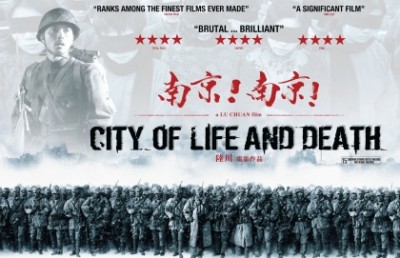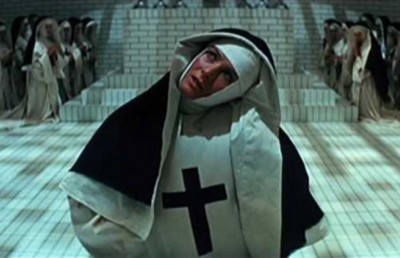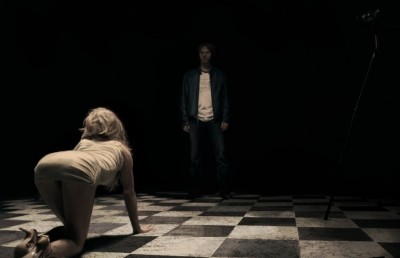Forevermore: Longevity at Fantasia 2010
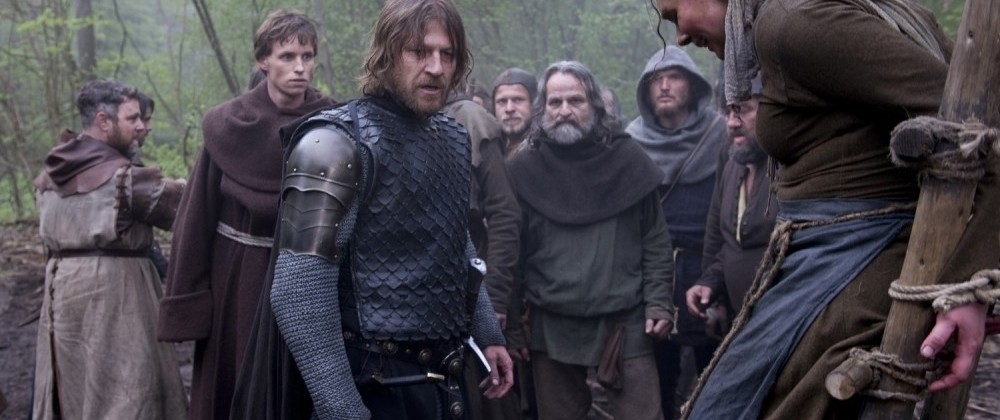
It’s mid-way through the festival. I’m sitting in the dimmed Hall Theatre a good 30 minutes in advance of the start time for LEMMY, the new documentary profile of Motorhead cornerstone Lemmy Kilmister. The pre-show tunes are blasting as usual. But after a while I become aware that what we’re hearing is more than just a collection of energetically appropriate selections made by the projectionist du jour. No, amidst the increasingly excitable crowd of speed metal enthusiasts we hear Lemmy’s unmistakable voice singing through unconventional material, covers of other bands that declare his influences and interests in the process. There is real thought and exuberance behind these song choices, clearly the work of a true fan exploring the genre connections between Motorhead and other groups. Later I learn that this was the work of Concordia radio DJ Angelica, and a visit to her blog reveals a hard-core Lemmy fan and general hard-rock aficionado who really knows her shit. Somehow I had not been aware that she, and others like her, have been handpicking the pre-show materials at Fantasia for years. Needless to say, the subject of this particular film lent itself better to a coherent DJ set than most. Angelica’s programming captured not only the spirit of Lemmy but the spirit of Fantasia itself as a festival dedicated to exploring the boundaries of genre from hard-core staples through to the extremities of peripheral experimentation. I salute Angelica and the whole CJLO team in helping to make this festival truly exceptional among the genre festivals of the world.
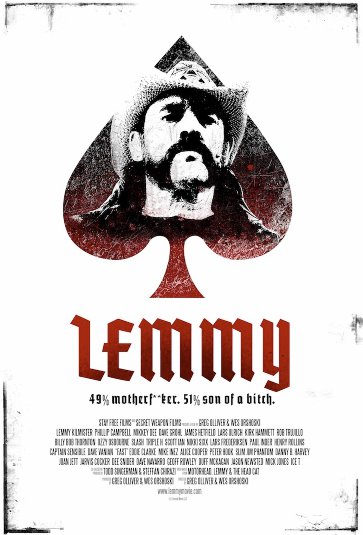
As it turns out, Lemmy was something of a signature film for this year’s festival, the story of rocker who has maintained the life amidst many sea changes and despite his ageing, a model that Fantasia itself has emulated in its 15-year history. In general, the rule of the rock superstar is simple: you live hard, hit your peak, and then either clean up or die. And if you clean up, you’ll probably suck afterwards. Okay, cue the chorus of baby-boomers extolling the virtues of modern-day Stephen Tylers and Mick Jaggers. Yes, they now have lots of good, clean energy. And yes, they suck for it. There are a few exceptions, of course, where hard-core rock lifers have broken free of the lifestyle and continued making important musical contributions. But this is the inverse of the Lemmy model: he has maintained the lifestyle consistently throughout his career, a steady flow of intoxicating substances flowing through the veins, living single in the same apartment he got when landing in L.A. in the 1980s, and all with a rock-solid track record of material coming down the pipeline.
Some years ago the documentary film Some Kind of Monster showed us the human side of Metallica, and made them look like losers in the process, adding to an already thick base of hostility towards the band after the Napster affair. Indeed, a raucous round of booing erupted during the Lemmy screening when Lars Ulrich first appeared for an interview to extol the man’s virtues. When Metallica invite him onstage as a mentor and idol, there is no sign of fadedness in the man. They patronize him a bit, masking their superiority complex behind a wall of tribute to the master. But they end up looking like the silly ones in the end, their new post-therapy trip paling in comparison to Lemmy’s unfailing commitment to the spirit that has always driven his music.
Meanwhile other rock stars have increased their popularity through a process of re-invention. The hit MTV show The Osbournes showed us a made-for-prime-time circus that nevertheless paints a very different picture of Ozzy than his status as the Prince of Darkness. This has only made him more popular in the disjunction between his stage presence and his domestic life, and more power to him for it. I love the show, but it is a high water mark for the model of the rocker who has to change course to stay alive. Lemmy has neither reformed like Metallica nor settled into a home life that belies his public persona like Ozzy. Lemmy is just Lemmy. Indeed, he would be a rather tragic figure if he didn’t kick so much ass.
Publicity for the film claims it reveals the “real” Lemmy, intending to take us behind the man and find out what makes him tick. And on this count I think it actually fails, for the man has clearly built himself a thick wall to the world and we get only the faintest glimpse at what lay behind, mostly through a couple moments of tenderness between he and his son. But to be honest I wasn’t really looking for tears of anguish here. Lemmy has built himself into a figure, and that’s what we see. He doesn’t show the man behind the wall to anyone. So what we see is what the world gets. No wife. Minimal family. And when not on tour, he plugs video lottery terminals all day at the Rainbow with his Jack and Coke.
What the film does do very effectively is to show us the world surrounding the figure, both historically and contemporaneously. We go back to the start when Lemmy was fired from legendary psych-rock outfit Hawkwind because of what the bassist calls “1970s drug snobbery” : they were into psychedelics, Lemmy was into speed. Lemmy paints this as hypocritical; how can one druggie condemn another? But I have no trouble understanding why these approaches to intoxication would clash; only the uninitiated squares at the DEA would consider speed to be in the same class as acid, or acid in the same class as pot. Lemmy’s gravitation towards the ephedral side of the psychoactive spectrum is clearly a major component in his development of the speed metal style that has won him so much success and allowed his music to survive long past the days when psychedelia and prog rock were in vogue. And it is clear that his continued success has the previous Hawkwind bandmembers resentful, one of the many aspects of Lemmy’s musical network that the film explores.
Lemmy’s down-to-earth nature comes out best in a telling scene with Billy Bob Thornton as they compare stories of royalty checks from their musical endeavors. Billy Bob got a check for $2,000.000 for Monsters Ball. “I went out and bought a case of bud,” he says, trying to be mister down home “no big whup” guy. Lemmy counters, “I got a hundred grand when Metallica recorded four of my songs. I’m not into the millions yet, but I’m working up to it.” And you know that Lemmy most likely stuffed the bills under his mattress and kept on keeping on, while Billy Bob likely took his can of bud to meetings with investment bankers to figure out how manage his money. Canadian listeners to Jian Gomeshi’s Q are now well aware of Billy Bob’s desire to be taken seriously as a musician, and his now famous levels of idiotic disdain for any member of the media who might make note of his film credits when interviewing him while on tour with his band. Inversely, Lemmy has done a lot of movie and TV walk-ons (we see him here doing an appearance on Californication), but doesn’t pretend anybody would care to see him on screen if it wasn’t for his status as metal god.
In short, Lemmy is the real deal, and is dangerous for being so. His reality is every rocker’s impossible fantasy. He’s like a Calvin Klein model for men’s cologne: a profound unreality that to emulate would spell one’s own destruction. And the film re-enforces this not by way of misleading omissions and valorization, but by a consistent effort to probe depths that may belie Lemmy’s stalwart exterior only to be frustrated at every turn. All we’re ever going to see of Lemmy is what he seems to be. And if you want to see that, then Lemmy is the film for you.
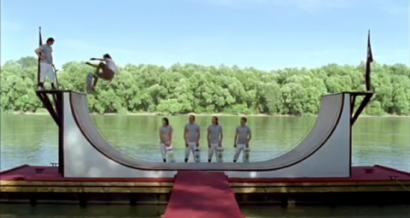
Machotaildrop
While Lemmy gives the impression that there is no behind-the-scenes reality supporting the bassist’s media face, the Vancouver-based skateboard film Machotaildrop goes in search of the problems of media constructions and their machinations. It’s the story of Walter Rhum, a young and promising skater who wants nothing more than to emulate his favourite pro, Blaire Stanley, under contract with the legendary board company Machotaildrop. He spends his days shooting demo tapes to try and get the company’s attention, and one day it pays off. However, when he arrives at the company’s estate (gorgeously shot in a lush area of Budapest), he discovers the ugly side of professionalization, skater personae being fabricated to fuel profits while attention to actual skating falls by the wayside. Here he finds Blair Stanley being harvested for his image and wasting away, and his own falsified media identity already in production before his arrival.
The skateboard film concept is very much like porno for skaters: hard-core skating sequences separated by weak narrative interludes driven by bad acting and low-budget production values. But this film differs on three key points: the acting isn’t bad, the production values are good, and the skating isn’t all that hard-core. The film doesn’t have enough skating sequences to be a full-on skater film, but it tries to make up for this with a much more elaborate plot line supported by decent performances. Indeed, its critique on the pro skateboard industry seems more important than a showy display of skills. But the real star of the film is the location shooting in Vancouver and Budapest along with the art direction. Although shot on video, the sets and costumes have a very late 60s / early 70s feel to them: the Machotaildrop boss insists that his skaters dress in the kind of vintage clothing that was re-popularized during the 60s psychedelic movement in San Francisco, and the mansion location in Budapest suits this vibe perfectly, again echoing the Victorian-style manors famously inhabited by the Haight’s counterculture. It feels like a time-capsule pointing back to the days before things got a little too rad in the skateboard world, before the era of helmet-mounted HD cameras, and before the individualization of skaters – each with their own signature board shape – gave way to the homogenization of style, any given skater now just a signature on a board that looks the same as any other.
In many ways, the film recaptured the essence of the holy grail of skate films when I was just starting out: The Search for Animal Chin, a showcase for the Bones Brigade wunderkinds under contract with Powell and Peralta in the 1980s. While the skating in Machotaildrop doesn’t hold a candle to what we see in Animal Chin, it does feature a search for a lost and mystical skating spot, the kind of search that formed the bare-bones plot of the Powell Peralta outing. One of the jobs of the skaters with Machotaildrop is to partake in a reality-style TV show where top skaters go in search of great new locations. While Rhum doesn’t find the equivalent of the legendary Animal Chin ramp out in the Mexican desert, but they do uncover the ruins of the Manwolf tribe, and here we find the film’s most inspired moments of urban street skating amidst the degrading concrete ripe with overgrowth from the lush forest that surrounds it. And here the 80s come roaring in when the Manwolfs appear to protect their territory sporting sleeveless denim jackets over black leather with their insignia on the back. Hairstyles and beards follow suit.
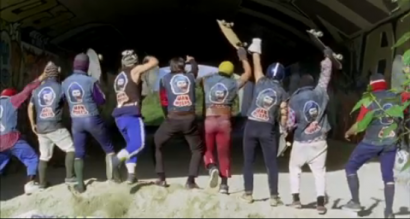
Machotaildrop
And here the plot thickens beyond the limits of a film like Animal Chin as the Machotaildrop company plans to co-opt the Manwolf space, pushing the locals out and forming a corporate amusement park to be called “Ape Snake.” Dogtown and Z-Boys taught us all about the results of the first generation of skaters going pro, with its successes and failures in the face of corporate control. In Machotaildrop the contracted skaters must consider the implications of their hand in aiding the company to drive the Manwolfs out of their land, and banishing the independent spirit that brought them to skating in the first place. Machotaildrop is about the perils of wanting to become a real-life version of an impossible model and the value of “keeping it real.” It is a charming outing with a nice blend of skate-film and psychedelic sensibilities, sharing the anti-institutional anarchy of the best films from both genres.
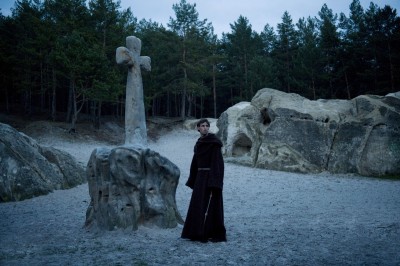
Black Death
Another media savvy entry this year was, surprisingly enough, a tale of plague-era witch-hunting: Christopher Smith’s Black Death. Wonderfully shot on super-16mm for a deliberately textured look that reflects the film’s foray into the filth of a Europe in the grips of the Black Plague, the film features excellent performances and a compelling story that keeps you guessing about whether or not character-stated beliefs in supernatural forces truly exist within their world. The story centers upon a village unscathed by the plague and thus thought by Christian authorities to be under the influence of a witch. That her “powers” might be for good is not something considered acceptable by the Church and she is to be killed by an envoy of mercenaries.

Black Death
And so the film sets up a critique of the Church’s stance that the Plague was a necessary burden, a function of God’s will, vilifying those who escape its clutches as possessing powers of darkness. Things take an interesting turn when we discover that the supposed witch is just an herbalist, keeping the scourge at bay through natural medicines while pretending to harness supernatural powers in order to keep control over her village.

Black Death
Although a rebel against the Church, she, too, is preying on the faith of her people as a means of social control. And like the Church, she is also guilty of killing to protect her position. She tries to force the envoy to turn against their Christian god. In Ken Russell’s The Devils, also screened at this year’s festival (in the presence of the director), women of Christ are tortured under the mantra “confess!”, their souls to be saved if their communion with the devil is admitted to. In Black Death the recurring phrase is “renounce!”, a reversal of power where men of the Church are put to the test to see if they will turn their backs on Christ, and their government, in order to save their own skins. And so the film becomes a parable for issues concerning the abuse of religious and political power still relevant today, and the role of faith in governing how we deal with the perils of being human in a natural world. While working well as a dark and hard-hitting period piece that should satisfy most members of any regional Medieval recreationist society, it also demonstrates the longevity of issues pertinent to all human civilizations regardless of period or region. In the end the film withholds judgment in favour of pondering the ambiguities surrounding power, corruption and killing in the name of King, country, and God.

Crows Zero: 2
As with every year, my expectations for the mandatory Takashi Miike entry/ies ran high, although his recent offerings have not matched the heyday of the early 2000s when he blew the doors off of the Imperial theatre with Audition, Dead or Alive parts 1 and 2, and Visitor Q. But I just can’t help but think that through his Fassbinder-like production pace there ought to be gems emerging on a regular basis. But truth be told, Big Bang Love was the last of his films to catch my interest, hoping that its dramatic stylistic turn from anything he had previously done was a herald of great things to come. Sadly, we have yet to see any direct descendants from that film, most of his recent work following predictable trends in his fetish for gangster fare or his increasing work with studio franchise installments. And the latter was the case with this year’s entry Crows Zero: 2, a sequel to a prequel based on the popular manga. My spirits were raised a bit when the film started with beautiful shots of crows descending on a pier, extending a major recurring interest in bird imagery that I analyzed in my report on Miike’s films at Fantasia 2003. Here the crows land next to the gang leader around which the film revolves, and we are given some words to place the bird imagery in context: “These are the crows. They don’t flock together easily, but it is better to be a crow flying free than a bird in a cage.” And that just about ends any overt references to the animal kingdom and the story of gang conflict takes over in earnest. There are some nice flourishes here and there, like the image of a hole melting through the film opening up during a crane shot booming up from the body of a rival gang leader dead in the street. And throughout the film there is a visceral energy and raw quality that is very Miike indeed. But franchise necessities, like a string of J-pop performances running throughout, relegate the film to more of a vehicle for product-placement than cinematic experimentation. And at 133 minutes the film is about an hour too long.

Birdemic
A far more entertaining bird-related entry this year was James Nguyen’s Birdemic: Shock and Terror, a film so truly bad on pretty much every level that it makes Troll 2, the so-called worst movie ever made featured at last year’s festival, look like a bona fide masterwork. No, here we are in the realm of establishing shots that linger too long, driving-to-work montages that go on forever, location sound from the microphone on the low-grade handycam left in tact, and special effects that aren’t so special. But there is something about the film’s earnestness in the recounting of a tale of a city besieged by bird attacks that has attracted a vast audience and ensured the film’s robust distribution and lively midnight screenings. But the best part was the question period. The first question came from the mandatory “state your influences” category, a staple of the festival Q+A session. But I was utterly unprepared for the inanity of this particular variant on the theme: “Was the ending inspired by Hitchcock’s The Birds?” The question was so ridiculous that I burst out laughing louder than at anything in the film. I mean, what is he going to say: “No”? But to his credit, Nguyen actually moved past the obviousness of the film’s debt to Hitchcock’s bird outing to reveal a deeper and more carefully considered relationship to the famed director. “Many of you are laughing at the imperfections, perhaps laughing with, but despite these imperfections I think the film is a success because of the romantic thriller formula,” a strategy he says he learned from Hitch. And with answers like that it became hard to figure Nguyen out. This movie is not just pretend bad, it is actually bad, and Nguyen seems to be in a position of reflection upon this quality of his work. Perhaps he didn’t realize how bad the film was until its reception, but instead of getting defensive, like Troll 2??’s director Claudio Fragasso, he has embraced the awfulness, arriving at the screening with hundreds of coat-hangers to pass out so that the audience might raise them high during the scene when the film’s heroes use them to fight back against their winged enemies. And Nguyen has clearly recognized the benefits of the film’s popularity, helping him spread what seems to be an earnest environmental message. “Maybe it’s too late to save the environment, but technology changes every six months – the iPhone G4 just came out – so who knows what technology might emerge to help us solve the problem.” And here Nguyen pays another tribute to Hitchcock whose own bird film was inspired, in part, by environmental concern. But Nguyen is being compared closer to Ed Wood than Hitchcock. Only time will tell if ??Birdemic has the longevity of Wood’s notorious trash.
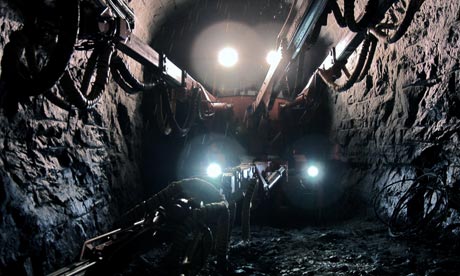
Into Eternity
On the subject of trash, one of the festival’s real gems was the documentary Into Eternity from Danish filmmaker Michael Madsen. The film examines Finland’s design and implementation of the Onkalo project, the world’s first permanent storage facility for nuclear waste set deep underground in a vast area of solid rock. The film sets a somber tone, weaving parallel tracks of construction footage and interviews with experts who ponder the unknowable: how to design a facility that will remain safe 100,000 years into the future? This question goes beyond the engineering skill required to build something that must last far longer than anything ever built by humans has lasted. Even if taken for granted that humans have enough knowledge to build a facility that won’t leak or break down over such a long period, how can we ponder what the world will be like as far into the future from today as the birth of our species is in the past? As such the film becomes as much about our concept of time and our own evolution as about the perils of the nuclear age. The film spins off a dizzying array of potential scenarios, many of which are at odds with each other. For example, do you leave warning signs about the facility’s dangers, or not? If so, what language will people speak in 100,000 years? If they misinterpret the signs, they may open it up thinking it is something valuable. Even if they do understand the signs, they may not heed their warning. So some argue that it should be left unmarked in the hopes that it will be forgotten. But if left unmarked and something goes wrong, who will be there to maintain it when knowledge of the facility has faded away? I suggest they should send Lemmy in to stand guard. Give him a video lottery terminal and an endless supply of bourbon and he would likely be happy as the guardian of the secret for all time. No but seriously, the film is a powerful meditation on the realities of the nuclear age, made all the more poignant when we realize that while Finland is the first to be acting on the idea of a permanent storage facility, it only produces a relatively small percentage of all the world’s nuclear waste. We will need thousands of such sites to manage waste if nuclear power is embraced as the solution to the world’s energy crisis. And if the questions posed by the Onkalo project seem unanswerable, it may be an impossible task.
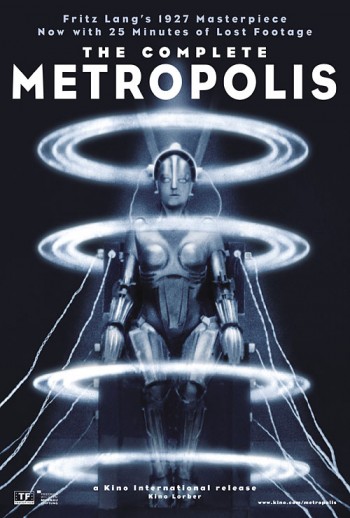
Speaking of longevity, this year’s festival featured an unusually rich array of retro screenings as well, each of which has stood the test of time incredibly well. I couldn’t have been more excited to see Ken Russell’s masterpiece The Devils on the big screen, presented in tandem with a retrospective held by the Cinémathèque Québecoise and the occasion of Russell’s receipt of a life-time achievement award. Sadly, there remains intense controversy over the film’s public presentation, and Fantasia was unable to acquire either a print or an uncut version of the film. Nevertheless, the video copy was acceptable and it was great to see the film with an enthusiastic Fantasia audience. And with its own brand of seething critique of the joining of Church and State it made for an excellent counterpart to Black Death. I was also blown away by an excellent print of Kaneto Shindo’s Kuroneko, perhaps my favourite film at the festival this year and a revelation on the big screen. And of course the big event this year was the screening of the latest restored version of Fritz Lang’s Metropolis, selling out the 3,000 seat Wilfred-Pelletier hall and featuring a newly composed score by Montreal’s own Gabriel Thibeaudau performed live with the film. Metropolis asks what the world might look like in the future if the socio-economic problems of its time remain. A question Lang might not have thought to ask would be what his film might look like in a century. This restored version offers an answer, though not one Lang would be entirely satisfied with. The film now contains a number of shots newly discovered on an Argentinean release print, offering interesting extensions of a couple of the film’s subplots. Sadly, however, the print they sourced the new shots from is so badly damaged that they simply could not clean it up well enough to integrate nicely with the rest of the beautifully restored film that has been on the circuit for some years. So there are regular shifts from the rather pristine footage we’re all familiar with to horribly scratched and murky snippits, making for a bit of a disjointed experience that feels more like having an “integrate deleted scenes” function activated on a DVD rather than watching a newly integral masterpiece. Nevertheless, the screening was enlightening, and marked a turning point for the festival’s ability to command respect as a major cultural player in Montreal.
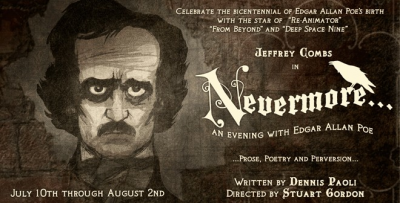
For me, however, the most striking resurrection of the festival was to be found in the embodiment of Edgar Allan Poe by Jeffrey Combs, in town with director Stuart Gordon and writer Dennis Paoli to present their one-man show Nevermore along with a midnight screening of their classic The Re-Animator. I arrived at the newly refurbished Rialto theatre under a heavy sky: dark in the east but with bright sun in the west casting light on buildings making them pop against the dark sky, bolts of lightening on the horizon breaking into a major thunderstorm just seconds after parking my bike and finding shelter. This was a fitting set-up for amazing show, both a recreation of and reflection upon the public readings Poe resorted to in his final years, low on funds from a drinking problem and its attendant woes. Combs’ performance was highly nuanced and revealed an actor of skill well beyond what is visible in the bulk of his motion picture production, the best of which remains on display in The Re-Animator.
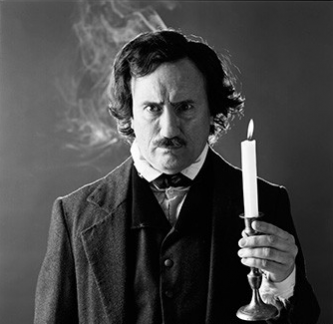
Despite the press emphasizing Combs’ reading of “The Raven” as the show’s centerpiece, the highlight for me came earlier with an inspired rendition of “The Tell-Tale Heart.” But the meat of the show came between readings as he addressed the audience directly on all manner of issues that plagued him in his later years. In some of these seemingly impromptu rants he demonstrates a sense of superiority and frustration at his lot, such as when he complains about the popularity of authors he considered to be his inferiors, jabbing at the moralizing of Washington Irving in “Sleepy Hollow” and suggesting his own work is better because it leaves the stories with you to make of them what you will. He also regularly addressed an invisible fiancée in the audience, also a literary critic, who has implored him not to rant against his contemporaries, or to drink. But he does both, and she leaves the building as Poe’s drunken stumblings become increasingly tense. Indeed, a convincing teeter on the edge of the stage had the front row a bit worried, only to be topped later by a full-fledged tumble from stage to floor, convincing enough to leave many of us to wonder if it was intentional. His performance had a great deal of emotional depth, from the cockiness of a self-assured author rendering his work with ease to moments of silent despair upon the discovery of a pressed flower in his book, the meaning of which is not revealed, but which sends him into moments of grave seriousness. This is top-tier theatre, and Combs should be recognized as a fantastic actor. He should be utilized better in films, and hopefully this production will help him land some good projects in the future.
Nevermore provides an alternative vision to Lemmy, emphasizing the waning of literary superstar Edgar Allan Poe who did not give up the fast life and had his work suffer for it, emphasizing the author’s personal frailty while demonstrating the continued relevance of his work. Like the Metropolis gala, this kind of event steps up Fantasia’s game and gives me great hope for the future of the festival to spread its wings wider while maintaining the core of it’s spirit. Let’s hope for a Lemmy-inspired festival model in years to come rather than one that follows the path of Poe.




